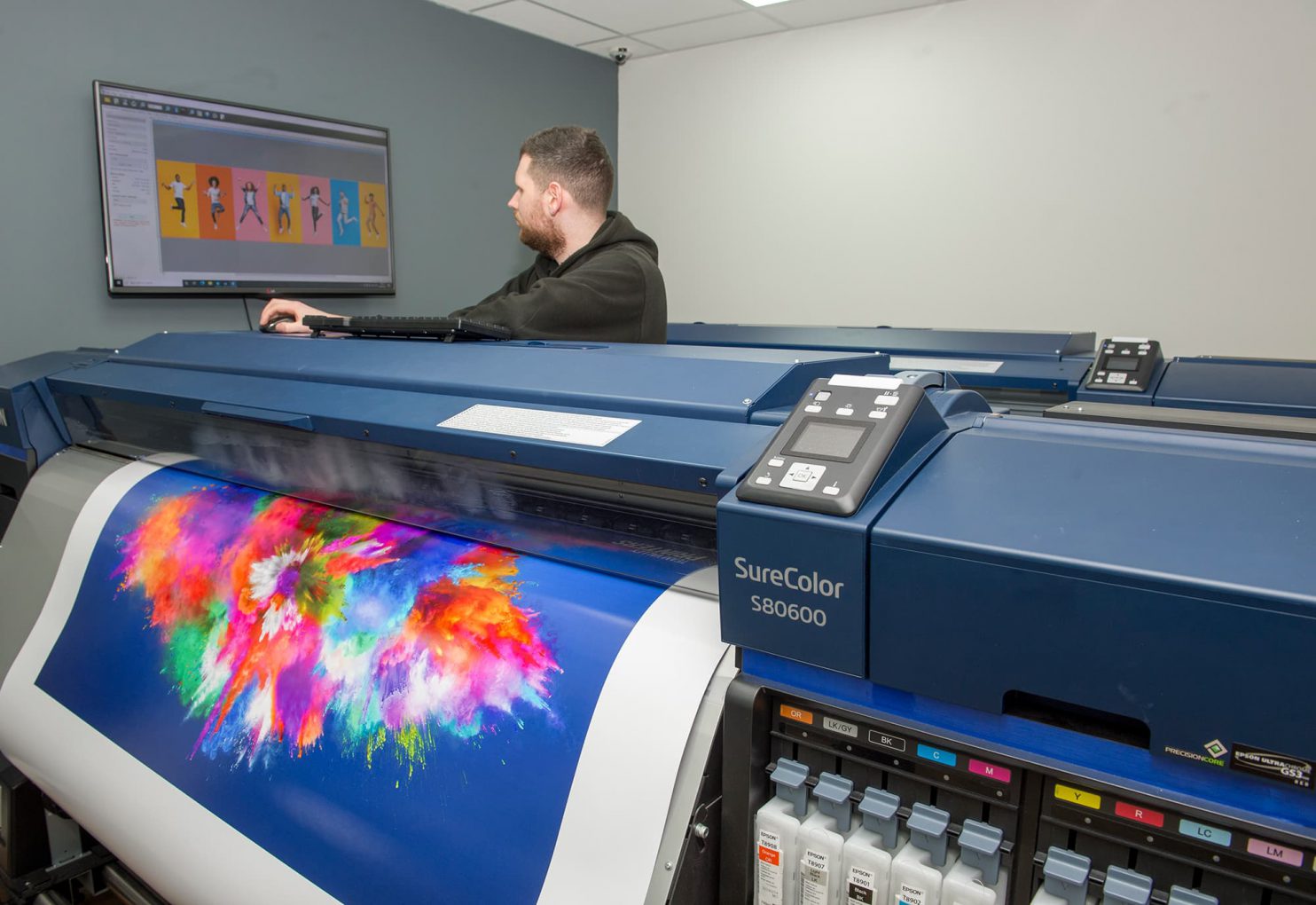In a world where visual storytelling is paramount, the ability to print large images has become an essential skill for artists, photographers, and marketers alike. Whether you're looking to decorate your space with breathtaking artwork or promote your business with eye-catching posters, printing large images can make a significant impact. But it’s not just about having a great image; it’s about the whole process, from choosing the right tools to understanding the intricacies of large format printing. This guide is to help you navigate the exciting world of large image printing, ensuring that you achieve stunning results every time.
Choosing the Right Printer for Large Format Printing

When it comes to large format printing, selecting the right printer is crucial for achieving professional-quality results. Here are some key factors to consider:
- Printer Type: There are generally two types of large format printers: inkjet and laser. Inkjet printers are versatile and produce vibrant colors and detailed prints, making them ideal for photographs and graphics. On the other hand, laser printers tend to be faster and more efficient for text-heavy documents.
- Print Width: Determine the maximum width you need for your prints. Common sizes range from 24 inches to 60 inches and beyond. Make sure the printer can accommodate the dimensions of your projects.
- Print Quality: Look for printers that offer high resolution (at least 1200 dpi) for crisp and clear images. Pay attention to the type of inks used as well; dye-based inks offer brilliant colors, while pigment-based inks provide longevity and fade resistance.
- Media Compatibility: Ensure your chosen printer can handle a variety of media, such as canvas, photo paper, or vinyl. This flexibility can enhance your creative options.
- Cost Considerations: Large format printers can vary widely in price. Be sure to evaluate your budget, keeping in mind both the initial investment and ongoing costs like ink and media.
By carefully considering these elements, you can choose a printer that fits your needs perfectly, setting the stage for stunning large image prints!
Also Read This: How to Upload Your Creative Work on Behance
Preparing Your Image for Printing
Getting your image ready for printing is a crucial step that can make or break the quality of the final product. Let’s dive into how to prepare your image to ensure you achieve stunning results!
First off, consider the format of your image. Ideally, you want to work with a high-quality format such as TIFF or PNG, which preserve more detail than JPEG. Here’s a quick checklist to help you:
- Check the Dimensions: Make sure your image has enough pixel dimensions to avoid pixelation when enlarged. Aim for at least 300 DPI (dots per inch) for crispness.
- Adjust the Color Settings: Convert your image to the CMYK color space. Printers operate in CMYK (Cyan, Magenta, Yellow, Black), which can significantly affect how colors appear.
- Edit for Sharpness: Use sharpness filters to enhance details, but be cautious not to overdo it—this can lead to unwanted artifacts.
- Consider Cropping: If necessary, crop the image to fit the desired aspect ratio of your print size. Keep in mind how the image will look once printed.
Lastly, take a moment to perform a test print on a smaller scale. This can help you identify potential issues before committing to the final print. Keeping these steps in mind can make all the difference!
Also Read This: Incorporating Adobe Stock Images in Photoshop
Understanding Print Resolution and Quality
When it comes to printing large images, understanding print resolution and quality is essential to getting impressive results. It’s all about how much detail your image holds and how well it transfers onto paper.
Resolution is commonly referred to in DPI (dots per inch) or PPI (pixels per inch). Here’s a simple breakdown:
| Resolution Type | Recommended DPI/PPI | Use Case |
|---|---|---|
| Low Resolution | 72-150 DPI | Web and digital screens |
| Medium Resolution | 150-300 DPI | Standard printing, like flyers and posters |
| High Resolution | 300+ DPI | High-quality prints, like photography and fine art |
It’s important to remember that higher resolution images result in better quality prints, but they also demand more storage space and processing power. When printing large images, every detail matters, especially if you’re showcasing your work in a gallery or for client presentation.
In summary, the crux of print quality lies in the resolution. Aim for at least 300 DPI when printing large images to ensure those details shine!
Also Read This: Watch the Packers Game on YouTube TV – Your Complete Guide to Streaming NFL Games
Selecting the Best Paper Type
When it comes to printing large images, the choice of paper can make or break the final result. Just like a canvas for a painter, the right paper type can elevate your artwork to another level. But with so many options available, how do you choose?
First, consider the finish you desire. Here’s a quick rundown of common paper finishes:
- Glossy: This finish enhances color vibrancy and gives your images a shiny, reflective surface. It’s perfect for photographs and vibrant images.
- Satin or Semi-gloss: A middle ground between glossy and matte, satin finishes reduce glare while still enhancing color.
- Matte: If you want a more subdued, artistic look, matte paper is the way to go. It absorbs light and shows less glare, but colors may appear slightly muted.
- Canvas: For a more textured feel, canvas is an excellent choice. It gives your prints depth and can even be gallery-wrapped for display.
Another factor to consider is weight. Heavier papers are often more durable and can provide a richer feel. Look for papers that weigh over 200 gsm (grams per square meter) for high-quality prints.
Finally, check if the paper is compatible with your printer. Some printers work better with specific paper types, so always double-check before making your purchase. Ultimately, the paper you choose will have a significant impact on the overall impact of your printed image.
Also Read This: How to Edit Text in an Image While Matching the Same Font
Using the Correct Printing Software
Let’s talk about another essential component in the printing process: software. Choosing the correct printing software can significantly affect the quality of your large image prints. You wouldn’t want to pour your heart into a stunning photo, only to have it ruined by improper software settings!
Here are some key features you should look for in printing software:
- Resolution Settings: Ensure the software allows you to set the appropriate DPI (dots per inch) for large images. Aim for at least 300 DPI for high-resolution prints.
- Color Management: Choose software that supports Adobe RGB or CMYK color profiles. This is crucial for maintaining color accuracy.
- Print Preview: A print preview feature is essential. It helps you visualize how your image will appear on paper before you hit the print button.
- Crop and Resize Tools: Being able to easily adjust image dimensions and crop unnecessary parts is vital for getting that perfect print.
Some popular options for printing software include Adobe Photoshop, Lightroom, and specialized programs like Print Studio Pro. Each of these offers various features that cater to professionals and enthusiasts alike.
In short, using the right printing software ensures that every detail of your large image is captured accurately and beautifully. Take the time to explore and experiment with different options, and you’ll be well on your way to stunning printed images!
Also Read This: Splitting an Image to Print on Multiple Pages
7. Calibrating Your Printer for Optimal Results
When it comes to printing large images, calibration is crucial. Imagine putting hours into perfecting an image only to have it printed with colors that are off or details that are lost. Calibration ensures that what you see on your screen closely matches what comes out of your printer. Here’s a step-by-step guide to help you get started:
- Understand color profiles: Different devices have different color profiles. It’s essential to be aware of the RGB (used for screens) and CMYK (used for printing) differences. Make sure your software is set to the correct profile based on your final output.
- Use calibration tools: Invest in a color calibration device. This tool helps adjust the colors of your screen and printer to ensure they match. Tools like the X-Rite i1Display Pro are quite popular.
- Print test images: Use a sample image that includes a variety of colors and shades. Print this image to check for discrepancies between what you see on your screen and the printout.
- Adjust printer settings: Access your printer settings to fine-tune options such as paper type and print quality. Choosing the correct paper is vital, especially for large images.
- Regular maintenance: Don’t forget about regular printer maintenance! Clean the print heads and ensure there is enough ink to avoid inconsistencies.
By taking these steps, you’ll set yourself up for success and achieve the stunning results you desire when printing large images.
Also Read This: Using iStock Images in Presentations For Business and Personal Use
8. Common Challenges and Troubleshooting Tips
Even the most experienced photographers and printers face challenges when it comes to printing large images. Let’s explore some common issues and simple solutions to help you troubleshoot effectively.
| Problem | Possible Cause | Solution |
|---|---|---|
| Color discrepancies | Incorrect color profile settings | Check and adjust both screen and printer profiles to match. |
| Blurry prints | Low resolution of the image | Ensure your image is high-resolution (at least 300 DPI). |
| Surface imperfections | Dirty print head | Run a cleaning cycle on your printer. |
| Paper jams | Incorrect paper type or loading | Use the right type of paper and ensure it’s loaded correctly. |
Keeping these challenges and solutions in mind can help streamline your printing process. Remember, troubleshooting is part of the journey, and with a little patience, you’ll be rewarded with captivating prints that do justice to your large images!
Conclusion and Final Tips for Success
In conclusion, printing large images can transform your artwork into stunning visual displays that captivate and engage your audience. However, achieving the best results requires careful planning and execution. To ensure you maximize the potential of your large prints, consider the following final tips:
- Choose the Right Resolution: Ensure that your image has a high enough resolution for large printing, ideally at least 300 DPI.
- Select Quality Paper: Different types of paper can dramatically affect the look of your print; consider glossy, matte, or textured options based on your project.
- Calibrate Your Printer: Regularly calibrate your printer to maintain color accuracy and overall quality.
- Use Professional Printing Services: If you're unsure about the printing process, collaborating with a professional service can ensure high-quality results.
- Test Prints: Always request or create a test print to evaluate color, shadow details, and sharpness before committing to larger formats.
| Tip | Description |
|---|---|
| Image Scaling | Adjust the size of your image without losing quality using appropriate software. |
| Color Management | Use color profiles to ensure accurate color matching throughout the printing process. |
| Framing Considerations | Think about how you will frame or display your large print for optimal impact. |
| Lighting | Consider where your print will be displayed; lighting can greatly affect its appearance. |
By following these tips, you'll be well on your way to producing stunning large-format prints that make a lasting impression.
 admin
admin








